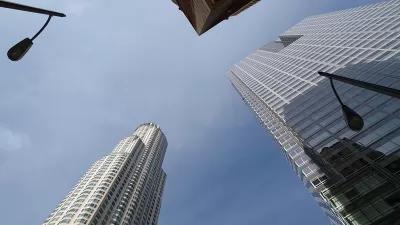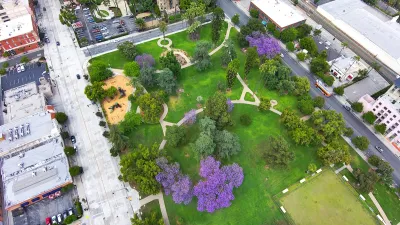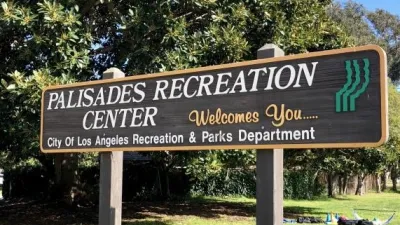When a glass slide installed 1,000 feet up the tallest skyscraper on the West Coast is more than it appears.

You might have already encountered footage of the Skyslide in Los Angeles being flown into place by a large helicopter, or of the first terrified human guinea pigs sliding down the glass connection between the 70th and 69th floors of the U.S. Bank Tower in Los Angeles.
L.A. Times Architecture Critic Christopher Hawthorne visited the new tourist attraction that opened on June 25 and was inspired to conjure up a term that is surely applicable to many places around the country: bouncy-house urbanism.
First, Hawthorne dispenses with the formality of describing the experiencing of sliding down a glass enclosure some 1,000 feet above the pavement below: "The ride won’t exactly be a threat to Six Flags. Nor would I say I’m in a hurry to try it again. But it was an architectural experience, however brief, of a kind I don’t think I’ve ever had."
The slide is the result of a $50 million renovation that includes an observation deck, two new lobbies, a café, a "transfer floor," and a restaurant and bar. Bus, as Hawthorne notes, much more powerful forces are at work than a simple renovation of a building built for a different era of business:
Though it was more than 80% leased when it opened in 1989, by the time OUE scooped it up for $367.5 million three years ago the building was barely half full. And its problems are not unique: As white-shoe law firms shrink and expanding tech companies in L.A. increasingly move into restored warehouses or historic buildings, commercial skyscrapers around the country are struggling to find tenants.
Enter "bouncy-house urbanism." As Hawthorne notes, the building's new owners are hardly the first "to see a possible revenue stream in the desire of adults to pay money to act like children in downtown settings."
FULL STORY: Ride the U.S. Bank Tower's glass Skyslide with 70 floors of nothingness below you

Alabama: Trump Terminates Settlements for Black Communities Harmed By Raw Sewage
Trump deemed the landmark civil rights agreement “illegal DEI and environmental justice policy.”

Planetizen Federal Action Tracker
A weekly monitor of how Trump’s orders and actions are impacting planners and planning in America.

Why Should We Subsidize Public Transportation?
Many public transit agencies face financial stress due to rising costs, declining fare revenue, and declining subsidies. Transit advocates must provide a strong business case for increasing public transit funding.

Understanding Road Diets
An explainer from Momentum highlights the advantages of reducing vehicle lanes in favor of more bike, transit, and pedestrian infrastructure.

New California Law Regulates Warehouse Pollution
A new law tightens building and emissions regulations for large distribution warehouses to mitigate air pollution and traffic in surrounding communities.

Phoenix Announces Opening Date for Light Rail Extension
The South Central extension will connect South Phoenix to downtown and other major hubs starting on June 7.
Urban Design for Planners 1: Software Tools
This six-course series explores essential urban design concepts using open source software and equips planners with the tools they need to participate fully in the urban design process.
Planning for Universal Design
Learn the tools for implementing Universal Design in planning regulations.
Caltrans
Smith Gee Studio
Institute for Housing and Urban Development Studies (IHS)
City of Grandview
Harvard GSD Executive Education
Toledo-Lucas County Plan Commissions
Salt Lake City
NYU Wagner Graduate School of Public Service





























